
-
Find the right food for your pet
Take this quiz to see which food may be the best for your furry friend.
Find the right food for your pet
Take this quiz to see which food may be the best for your furry friend.
Featured products
 Adult 7+ Perfect Digestion Chicken, Whole Oats & Brown Rice Recipe Dog Food
Adult 7+ Perfect Digestion Chicken, Whole Oats & Brown Rice Recipe Dog FoodScience Diet's breakthrough nutrition supports ultimate digestive well-being & healthy microbiome for dogs age 7+
Shop Now Small & Mini Savory Stew with Chicken & Vegetables Dog Food
Small & Mini Savory Stew with Chicken & Vegetables Dog FoodA delicious complement to the nutrition of Science Diet Small & Mini 7+ dog food
Shop Now Adult Healthy Cuisine Roasted Chicken, Carrots & Spinach Stew Dog Food
Adult Healthy Cuisine Roasted Chicken, Carrots & Spinach Stew Dog FoodDelicious roasted chicken paired with tender vegetables in a succulent stew
Shop NowFeatured products
 Adult 7+ Senior Vitality Chicken & Vegetable Stew Cat Food
Adult 7+ Senior Vitality Chicken & Vegetable Stew Cat FoodImproves Everyday Ability to Get Up & Go
Shop Now Adult 7+ Tender Tuna Dinner Cat Food
Adult 7+ Tender Tuna Dinner Cat FoodWith delicious chunks in a decadent gravy
Shop Now Adult Savory Entrée Can Variety Pack Cat Food
Adult Savory Entrée Can Variety Pack Cat FoodPrecisely balanced nutrition with the delicious taste of savory minced chicken to help fuel the energy needs of cats during the prime of their life
Shop Now -
Dog
- Dog Tips & Articles
-
Health Category
- Weight
- Food & Environmental Sensitivities
- Urinary
- Digestive
- Joint
- Kidney
-
Life Stage
- Puppy Nutrition
- Adult Nutrition
- Senior Nutrition
Cat
- Cat Tips & Articles
-
Health Category
- Weight
- Skin & Food Sensitivities
- Urinary
- Digestive
- Kidney
-
Life Stage
- Kitten Nutrition
- Adult Nutrition
Featured articles
 Do Dogs and Cats have Belly Buttons?
Do Dogs and Cats have Belly Buttons?Learn whether cats & dogs have belly buttons like humans, what the function is, and if there are any health concerns associated with it.
Read More Does My Pet Hate Me?
Does My Pet Hate Me?Learn tips for bonding with your pet if you've ever thought, 'My dog doesn't like me, or 'Why do I have a standoffish cat?'
Read More Why Are Dogs and Cats So Cute?
Why Are Dogs and Cats So Cute?If waggy puppy dog tails and furry kitten yawns make you swoon, you're not alone. Why are cats so cute? And, dogs too! Let's find out!
Read More -


There's perhaps nothing more likely to bring a smile to a cat parent's face than seeing their kitty bat around a ball of yarn. Unfortunately, string and yarn are very dangerous for cats.
Signs That Your Cat Ate String
Often, pet parents aren't present to see that their cat swallowed string. So how can you tell if your cat ingested it? Vomiting is the most common sign that your cat has eaten string. Also, look for signs of abdominal pain, which your cat may show by hiding or being unusually aggressive when picked up. You may also see bloody diarrhea.
Dangers of a Cat Swallowing String
If your cat eats string, it will only cause an issue if a piece of it gets stuck somewhere between their mouth and gastrointestinal tract, while the other part is trailing farther ahead into the intestines. For example, a piece of yarn can get lodged at the base of a cat's tongue.
One of the biggest concerns of cats eating string is a condition veterinarians refer to as linear foreign body. The reason why this condition can cause so much damage is due to the way it can cause an intestinal obstruction says Manhattan Cat Specialists. "Usually, one end of the string becomes anchored, either by wrapping around the base of the tongue, or by getting lodged in the pylorus (the part of the stomach that leads to the small intestine). The peristaltic waves (peristalsis: the involuntary constriction and relaxation of the muscles of the intestine) generated by the intestines try to propel the free end of the string along the intestinal tract. But the leading end is lodged, so the string can't be pulled along." When this happens, the intestine can become folded, or plicated, which makes it not possible to pull the string out. As a result, the string can tighten and further exacerbate the risk of the intestines perforating (piercing a hole in the intestines).
Swallowing string can also cause a serious condition called intussusception. Intussusception results in the vigorous contraction of a specific bowel segment in an effort to move along an object that isn't passing through. If untreated, this part of the bowel can collapse into a nearby segment and lead to partial or complete GI obstruction, compromised blood flow to the affected section of the bowel, and tissue death. Intussusception can be fatal, according to the Merck Veterinary Manual.
A cat suffering from a linear foreign body creates a fairly difficult situation for a veterinarian due to the risk of perforations and the difficulty of removing the string says VIN. Cats with chronic linear foreign bodies (meaning they have them frequently) may be suffering from malnutrition, dehydration, or peritonitis, as well as potentially extended surgeries that can put a cat's life at risk.
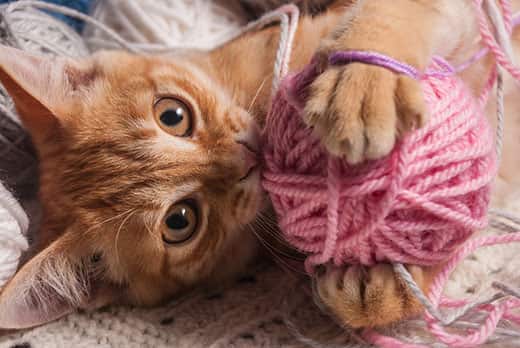
What to Do If Your Cat Swallowed String
If you know that your cat ate string, even if it's only been partly swallowed, resist the urge to pull it out yourself. While string is dangerous to ingest, the danger isn't immediate — you have time to seek veterinary care. If you try to remove the string yourself, you risk damaging the esophagus and causing choking or vomiting that could result in aspiration pneumonia (a lung infection).
Head to your vet's office promptly. Call them while you're on your way to give them a heads-up about the situation. After you arrive, your vet will examine your cat. Be prepared for them to ask to anesthetize your pet; this allows them to completely examine the oral cavity, including underneath the tongue.


Tasty Tips
Treatment for a Cat Who Swallowed String
If your vet can't locate the string and the incident occurred recently, they may induce vomiting in your cat. If it's been a while since your cat swallowed the string, then your vet may try to retrieve it with an endoscope, a flexible tube with a camera attached that's inserted into the stomach via the mouth. If they locate the string during the endoscopy, it can be safely removed. While this procedure does require anesthesia, it's brief and very safe; your cat should be ready to head home by the end of the day. After any procedure involving anesthesia, your cat may have a slight drop in energy, decreased appetite or a scratchy-sounding meow for a day or two. Typically, no special modifications to your cat's routine or medicine are needed after this procedure.
If your cat has developed signs of illness by the time you bring them to a clinic, the vet may recommend an abdominal ultrasound or radiographic contrast studies (X-rays using a contrast dye to help organs show up easier). If the string was swallowed more than two to three days ago, or if your cat is clearly ill from the incident, your vet will likely suggest surgery — and the sooner it happens, the better.
If your cat has surgery, your feline friend will probably need to stay at the hospital for several days to ensure there are no major complications and that their intestines have regained full function. Home care can include pain medicine and antibiotics to give your cat, in addition to a food that is easily digestible such as Hill's Prescription Diet i/d.
How to Keep Your Cat Safe During Playtime
Follow these tips to provide a safe and stimulating environment for your cat, and to avoid wondering whether they've swallowed their toy:
- Use feeding toys. They provide mental engagement and encourage slower eating, which often results in fewer episodes of vomiting after snacking.
- Other safe toy options include crinkle balls, plastic milk jug tabs, a catnip mouse or another toy to bat around, and feather wands.
- Avoid letting your cat play with streamers, yarn, wands with dangling toys and toys with accessories sewn or glued on, as these can easily be disassembled by a feisty kitty.
- Don't let your cat play with toys unattended.
- Make sure to put any string or yarn out of your cat's reach. This can include floss, sewing thread, and fishing line.
Kittens, with their seemingly unlimited energy and curiosity, are at an increased risk of swallowing string. But it's important to keep cats of all ages safe from the dangers of string by choosing vet-approved toys and knowing the signs of a GI obstruction. If you think your cat might've eaten string, contact your vet.


Dr. Laci Schaible is a small animal veterinarian, veterinary journalist, and a thought leader in the industry. She received her Doctor of Veterinary Medicine from Texas A&M University and her Masters in Legal Studies from Wake Forest University.
Related products

Precisely balanced nutrition with the delicious taste of savory minced chicken to help fuel the energy needs of cats during the prime of their life

Supports energy level and beautiful fur in mature cats

With delicious chunks in a decadent gravy

Improves Everyday Ability to Get Up & Go
Related articles
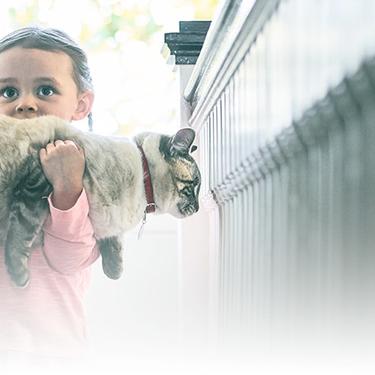
Discover how to identify cat sensitive skin and what you can do to help your cat thrive from head to paw.
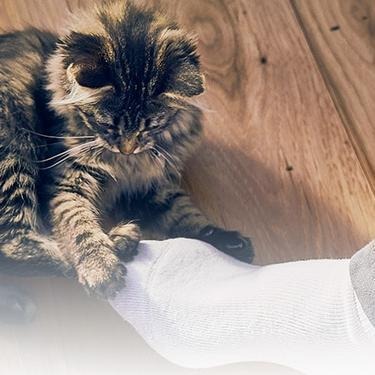
Discover which cat toys games your feline friend might like, and how they are great sources of exercise. Explore our library of articles to learn more.
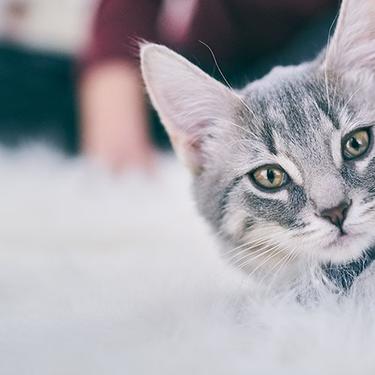
Discover the benefits of Hill's line of kitten foods and how they provide complete and balance nutrition for growing kittens.
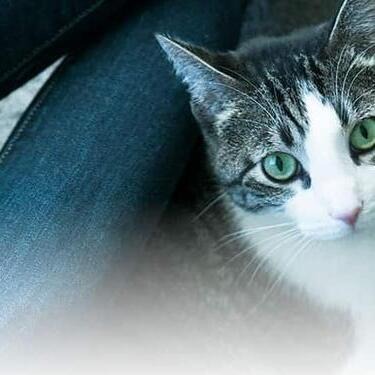
Brushing your cat's teeth is just as important as brushing your own. Learn signs or oral health problems in your cat and how to avoid them.

Put your cat on a diet without them knowing
Our low calorie formula helps you control your cat's weight. It's packed with high-quality protein for building lean muscles, and made with purposeful ingredients for a flavorful, nutritious meal. Clinically proven antioxidants, Vitamin C+E, help promote a healthy immune system.
Put your cat on a diet without them knowing
Our low calorie formula helps you control your cat's weight. It's packed with high-quality protein for building lean muscles, and made with purposeful ingredients for a flavorful, nutritious meal. Clinically proven antioxidants, Vitamin C+E, help promote a healthy immune system.

